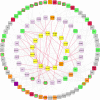Transcriptional and epigenetic responses to mating and aging in Drosophila melanogaster
- PMID: 25344338
- PMCID: PMC4221674
- DOI: 10.1186/1471-2164-15-927
Transcriptional and epigenetic responses to mating and aging in Drosophila melanogaster
Abstract
Background: Phenotypic plasticity allows organisms to respond rapidly to changing environmental circumstances, and understanding its genomic basis can yield insights regarding the underlying genes and genetic networks affecting complex phenotypes. Female Drosophila melanogaster undergo dramatic physiological changes mediated by seminal fluid components transferred upon mating, including decreased longevity. Their physiological and behavioral effects have been well characterized, but little is known about resulting changes in regulation of gene expression or the extent to which mating-induced changes in gene expression are the same as those occurring during aging.
Results: We assessed genome-wide mRNA, microRNA, and three common histone modifications implicated in gene activation for young and aged virgin and mated female D. melanogaster in a factorial design. We identified phenotypically plastic transcripts and epigenetic modifications associated with mating and aging. We used these data to derive phenotypically plastic regulatory networks associated with mating of young flies, and aging of virgin and mated flies. Many of the mRNAs, microRNAs and epigenetic modifications associated with mating of young flies also occur with age in virgin flies, which may reflect mating-induced accelerated aging. We functionally tested the plastic regulatory networks by overexpressing environmentally sensitive microRNAs. Overexpression resulted in altered expression of ~70% of candidate target genes, and in all cases affected oviposition.
Conclusions: Our results implicate microRNAs as mediators of phenotypic plasticity associated with mating and provide a comprehensive documentation of the genomic and epigenomic changes that accompany mating- and aging-induced physiological changes in female D. melanogaster.
Figures







Similar articles
-
A genome-wide analysis of courting and mating responses in Drosophila melanogaster females.Genome. 2004 Oct;47(5):900-10. doi: 10.1139/g04-050. Genome. 2004. PMID: 15499404
-
The effect of mating history on male reproductive ageing in Drosophila melanogaster.J Insect Physiol. 2018 Nov-Dec;111:16-24. doi: 10.1016/j.jinsphys.2018.10.003. Epub 2018 Oct 9. J Insect Physiol. 2018. PMID: 30312587
-
Immunogenic males: a genome-wide analysis of reproduction and the cost of mating in Drosophila melanogaster females.J Evol Biol. 2009 May;22(5):964-73. doi: 10.1111/j.1420-9101.2009.01708.x. Epub 2009 Feb 18. J Evol Biol. 2009. PMID: 19228270
-
Evolution of Reproductive Behavior.Genetics. 2020 Jan;214(1):49-73. doi: 10.1534/genetics.119.302263. Genetics. 2020. PMID: 31907301 Free PMC article. Review.
-
Mating induces developmental changes in the insect female reproductive tract.Curr Opin Insect Sci. 2016 Feb;13:106-113. doi: 10.1016/j.cois.2016.03.002. Epub 2016 Mar 11. Curr Opin Insect Sci. 2016. PMID: 27436559 Review.
Cited by
-
Small RNA Regulators of Plant-Hemipteran Interactions: Micromanagers with Versatile Roles.Front Plant Sci. 2016 Aug 30;7:1241. doi: 10.3389/fpls.2016.01241. eCollection 2016. Front Plant Sci. 2016. PMID: 27625654 Free PMC article. Review.
-
Age-Related Changes of Gene Expression Profiles in Drosophila.Genes (Basel). 2021 Dec 14;12(12):1982. doi: 10.3390/genes12121982. Genes (Basel). 2021. PMID: 34946931 Free PMC article.
-
Direct Testing for Allele-Specific Expression Differences Between Conditions.G3 (Bethesda). 2018 Feb 2;8(2):447-460. doi: 10.1534/g3.117.300139. G3 (Bethesda). 2018. PMID: 29167272 Free PMC article.
-
The molecular basis of socially mediated phenotypic plasticity in a eusocial paper wasp.Nat Commun. 2021 Feb 3;12(1):775. doi: 10.1038/s41467-021-21095-6. Nat Commun. 2021. PMID: 33536437 Free PMC article.
-
Divergence in Transcriptional and Regulatory Responses to Mating in Male and Female Fruitflies.Sci Rep. 2019 Nov 6;9(1):16100. doi: 10.1038/s41598-019-51141-9. Sci Rep. 2019. PMID: 31695054 Free PMC article.
References
-
- Weindruch R, Kayo T, Lee CK, Prolla TA. Microarray profiling of gene expression in aging and its alteration by caloric restriction in mice. J Nutr. 2001;131(3):918S–923S. - PubMed
MeSH terms
Substances
Grants and funding
LinkOut - more resources
Full Text Sources
Other Literature Sources
Medical
Molecular Biology Databases

